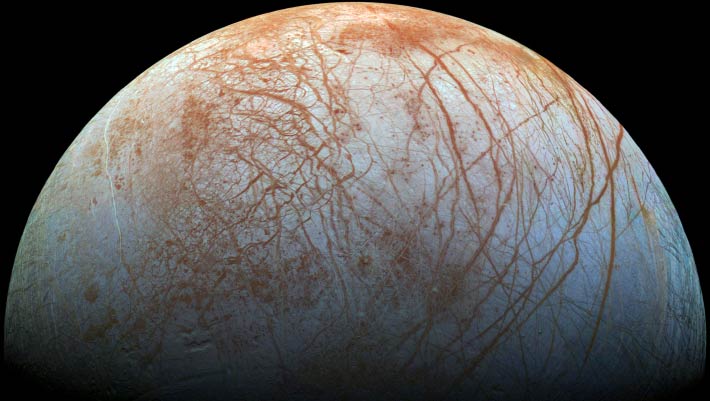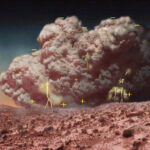University of Washington researcher Baptiste Journaux and colleagues believe the newly-created substances could form at the surface and bottom of deep oceans on Jupiter’s icy moons Europa and Ganymede.
This image of Europa, the smallest of Jupiter’s four large moons, shows red streaks across the surface; the discovery of new types of salty ice could explain the material in these streaks and provide clues on the composition of Europa’s ice-covered ocean. Image credit: NASA / JPL-Caltech / SETI Institute.
“It’s rare nowadays to have fundamental discoveries in science,” Dr. Journaux said.
“Salt and water are very well known at Earth conditions. But beyond that, we’re totally in the dark.”
“And now we have these planetary objects that probably have compounds that are very familiar to us, but in at very exotic conditions.”
“We have to redo all the fundamental mineralogical science that people did in the 1800s, but at high pressure and low temperature. It is an exciting time.”
At cold temperatures water and salts combine to form a rigid salted icy lattice, known as a hydrate, held in place by hydrogen bonds.
The only previously known hydrate for sodium chloride was a simple structure with one salt molecule for every two water molecules.
But the two new hydrates, found at moderate pressures and low temperatures, are strikingly different.
One has two sodium chlorides for every 17 water molecules; the other has one sodium chloride for every 13 water molecules
This would explain why the signatures from the surface of Jupiter’s moons are more ‘watery’ than expected.
“It has the structure that planetary scientists have been waiting for,” Dr. Journaux said.
“The discovery of new types of salty ice has importance not just for planetary science, but for physical chemistry and even energy research, which uses hydrates for energy storage.”

Journaux et al. discovered two new crystals made from water and table salt at low temperatures, below about minus 50 degrees Celsius; the known structure (left) has one salt molecule (yellow and green balls) to two water molecules (red and pink balls); the central structure has two sodium chloride molecules for every 17 water molecules and stays stable even if pressure drops to near vacuum, as would exist on a lunar surface; the structure on the right has one sodium chloride molecule for every 13 water molecules, and is stable only at high pressure. Image credit: Baptiste Journaux / University of Washington.
The team’s experiment involved compressing a tiny bit of salty water between two diamonds about the size of a grain of sand, squeezing the liquid up to 25,000 times the standard atmospheric pressure.
The transparent diamonds allowed the team to watch the process through a microscope.
“We were trying to measure how adding salt would change the amount of ice we could get, since salt acts as an antifreeze,” Dr. Journaux explained.
“Surprisingly, when we put the pressure on, what we saw is that these crystals that we were not expecting started growing. It was a very serendipitous discovery.”
Such cold, high-pressure conditions created in the lab would be common on Jupiter’s moons, where scientists think 5 to 10 km of ice would cover oceans up to several hundred km thick, with even denser forms of ice possible at the bottom.
“Pressure just gets the molecules closer together, so their interaction changes — that is the main engine for diversity in the crystal structures we found,” Dr. Journaux said.
Once the newly discovered hydrates had formed, one of the two structures remained stable even after the pressure was released.
“We determined that it remains stable at standard pressure up to about minus 50 degrees Celsius,” Dr. Journaux said.
“So if you have a very briny lake, for example in Antarctica, that could be exposed to these temperatures, this newly discovered hydrate could be present there.”
The findings will appear in the Proceedings of the National Academy of Sciences.
_____
Baptiste Journaux et al. 2023. On the identification of hyperhydrated sodium chloride hydrates, stable at icy moon conditions. PNAS, in press; doi: 10.1073/pnas.2217125120




